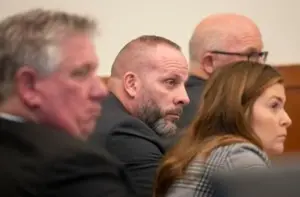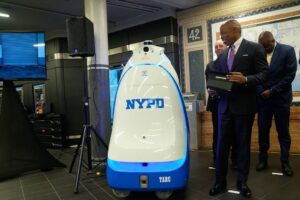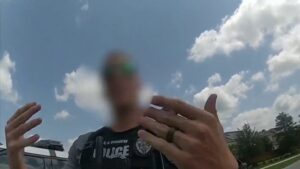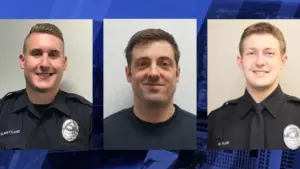To stop street takeovers, Conn. PD tracks down registered vehicle owners to warn of tickets
Connecticut police departments are employing a new tactic to combat the surge of illegal street takeovers and disruptive car meet-ups that have plagued communities across the state in recent years. Rather than simply responding to the scene and attempting to disperse the crowds, law enforcement agencies are now taking a more proactive approach by tracking down the registered owners of vehicles involved in these events and issuing stern warnings about the potential consequences of continued participation.
Police Identify and Warn Registered Owners of Offending Vehicles
In the city of Wethersfield, for example, Police Chief Rafael Medina recently sent letters to dozens of car owners whose vehicles were identified as being present at a massive, illegal car gathering in November that generated over 100 noise complaints from frightened residents in the surrounding neighborhoods.
“Our investigators have a video of your car trespassing … continuing disregard for traffic laws may result in more severe consequences,” Medina’s letter warned, putting the vehicle owners on notice that their involvement in such activities has been documented and that future incidents could lead to fines or other penalties.
Noise Complaints from Street Takeovers Prompt New Tactic
The November 19th gathering that prompted Wethersfield’s crackdown was particularly disruptive due to the nature of the noise generated by the participating vehicles. Rather than simply revving their engines or engaging in traditional street racing, many of the drivers had intentionally modified their exhaust systems to produce deafeningly loud backfires that sounded like gunshots, carrying the disturbance over a wide area and sparking panic among residents who feared they were under attack.
“The loud muffler has evolved from this race car-sounding, deep-throttle muscle car thing to the ones now where it backfires and sounds like gunshots,” explained Lt. Gustavo Rodriguez, the detective commander for the Wethersfield Police Department. “They do it intentionally for that backfiring noise. It’s a show-off thing.”
The Rise of Dangerous Street Takeovers During the Pandemic
Loosely Organized Gatherings Disrupt Communities
The surge in disruptive car meetups and street takeovers is a phenomenon that has plagued communities across the United States since the early days of the COVID-19 pandemic. As lockdowns and restrictions kept people isolated at home, young drivers and automotive enthusiasts began organizing loosely coordinated gatherings through social media, often taking over major intersections or stretches of highway to engage in reckless driving, burnouts, and other dangerous stunts in front of crowds of spectators.
Major Cities See Spike in Reckless Driving
While illegal street racing has been a problem for decades, particularly in urban areas, the pandemic ushered in a new level of disruption and danger. Major cities like Los Angeles, Houston, Atlanta, and San Diego reported a surge in these events, with large crowds showing up to watch as drivers performed dangerous maneuvers, weaving recklessly through traffic or intentionally slowing vehicles across all lanes to bring traffic to a crawl.
Social Media Fuels Pop-Up Races and Takeovers
Social media platforms like Instagram and X (formerly Twitter) played a significant role in facilitating these gatherings, with a few individuals in each city acting as organizers and using these channels to call for impromptu “flash mobs” of drivers and spectators. The loosely organized nature of these events made them incredibly difficult for law enforcement to predict or prevent, as participants could quickly disperse and reconvene in new locations at a moment’s notice.
Connecticut Faces Challenges with Street Takeovers
Violent Incidents and Property Damage
Connecticut has not been immune to the scourge of street takeovers, with several cities and towns reporting concerning incidents over the past few years. In some cases, these events have turned violent, with crowds assaulting police officers or throwing objects at patrol cars.
Crowds Assault Police and Throw Objects
In December of last year, a series of coordinated takeovers across multiple towns in the lower Naugatuck Valley escalated to the point where participants were throwing fireworks at responding officers. Video footage from the incident showed a crowd attempting to jump on the hood of a patrol car, while another clip captured the assault of a Milford police officer. To date, seven individuals have been charged in connection with these incidents, including a 19-year-old from Pennsylvania and a juvenile accused of throwing a shopping cart at an officer.
Thousands in Property Damage from Takeovers
Beyond the risks of physical violence, these gatherings have also resulted in significant property damage in some cases. Last summer, police in Farmington charged five individuals after a massive takeover in a commercial parking lot that involved over 150 vehicles and caused thousands of dollars in damage to the property.
Police Tactics to Prevent and Disperse Takeovers
Monitoring Social Media for Intelligence
Faced with the challenges posed by these fluid, unpredictable events, law enforcement agencies across Connecticut have developed a range of tactics to prevent and respond to street takeovers more effectively. One of the most crucial elements of this approach is the continuous monitoring of social media platforms to gather intelligence on planned gatherings or events.
“Our department learned of one that was to take place on January 13th, and we partnered with the FBI and Connecticut State Police to develop intelligence on the event,” said Lt. Tom Podgorski of the Norwalk Police Department. “In response to the information we planned a significant police response to strategically deter the participants and maintain order.” As a result of this proactive approach, the planned takeover never materialized.
Interagency Collaboration and Information Sharing
Collaboration and information-sharing between different law enforcement agencies have also proven to be essential in combating street takeovers. “To address the issue, officers used both marked and unmarked police cruisers to locate and stop the operators,” said Lt. Stephen Jacques of the Wallingford Police Department, describing his department’s efforts to crack down on ATV and dirt bike riders engaging in reckless behavior in coordination with officers from New Haven and the Connecticut State Police.
“Regarding investigations, the most important tool we have is to collaborate and exchange information with other agencies,” Jacques added.
Working with FBI to Deter Planned Events
In recognition of the severity of the issue, local police departments have even begun collaborating with federal agencies like the FBI to gather intelligence and deter planned takeover events. The Norwalk Police Department’s partnership with the FBI and State Police in anticipation of a January gathering is just one example of this heightened level of cooperation.
Using Video Evidence to Identify Participants
When incidents do occur, law enforcement agencies are also leveraging video evidence from various sources to identify and hold participants accountable. The Milford Police Department, for instance, has found success in reviewing dash cam footage, body cam recordings, and videos obtained from the public to “develop leads and identify suspects” involved in street takeovers within their jurisdiction.
Issuing Citations and Towing Vehicles
Once individuals are identified, police have employed tactics like issuing citations, towing vehicles, and pressing charges where appropriate. Wallingford’s Lt. Jacques noted that in addition to towing ATVs and dirt bikes, “operators were issued citations or charged accordingly for violations” when caught participating in reckless driving events.
Wethersfield’s Targeted Approach to Loud Mufflers
Noise Complaints from “Gunshot-Like” Backfires
While many police departments have focused their efforts on the dangerous driving aspects of street takeovers, Wethersfield’s recent crackdown highlights another significant issue associated with these gatherings: the intentional modification of vehicle exhaust systems to produce loud, gunshot-like noises that can terrorize surrounding communities.
Aftermarket Mods Produce Loud Pops and Bangs
“The loud muffler has evolved from this race car-sounding, deep-throttle muscle car thing to the ones now where it backfires and sounds like gunshots,” explained Lt. Gustavo Rodriguez of the Wethersfield Police Department. “They do it intentionally for that backfiring noise. It’s a show-off thing.”
Aftermarket automotive dealers have capitalized on this trend, offering specialized “burble tune kits” and even “AK47 tune kits” designed to modify mufflers and exhaust systems to produce the loud pops and bangs that mimic the sound of automatic gunfire. These modifications allow drivers to create a dramatic spectacle by revving their engines and producing a deafening series of backfires, often to the terror of nearby residents who mistake the noise for actual gunshots.
Identifying Registered Owners to Issue Warnings
In the case of the November 19th gathering in Wethersfield that generated over 100 noise complaints, police were unable to intervene directly as the crowd quickly dispersed upon their arrival. However, detectives have since reviewed security camera footage and dash cam videos to identify the registered owners of vehicles that were present, even tracking down out-of-state owners in some cases.
Letters Highlight Potential Consequences
Rather than immediately issuing citations or pressing charges, Wethersfield Police Chief Rafael Medina opted to send warning letters to these identified vehicle owners, putting them on notice that their involvement has been documented and that continued participation in such events could result in more severe consequences in the future.
“The purpose of the letter is to say ‘We know your car was here,'” explained Lt. Rodriguez. “There’s more than one instance where it was a parent’s car. You as the owner may not know what your friend or your kid is doing with your car. Hopefully, this will keep people from coming back and engaging in this behavior.”
Conclusion: A Multifaceted Response to Street Takeovers
The surge in illegal street takeovers and disruptive car meet-ups has presented a significant challenge for law enforcement agencies across Connecticut and the United States as a whole. Combating these fluid, unpredictable events requires a multifaceted approach that leverages social media monitoring, interagency collaboration, video evidence analysis, and both proactive deterrence and reactive enforcement measures.
While the tactics employed may vary from department to department based on the specific issues faced within their jurisdictions, one common thread emerges: a recognition that simply responding to these incidents as they occur is no longer sufficient. By taking proactive steps to identify participants, issue warnings, and escalate consequences for repeated offenses, police departments like Wethersfield’s are sending a clear message that such disruptive and dangerous behavior will not be tolerated within their communities.
As these events continue to evolve, so too must the strategies employed by law enforcement to maintain public safety and quality of life for residents. The innovative approaches being implemented in Connecticut, from social media monitoring to targeted warning letters, represent a crucial step in regaining control over a situation that had spiraled out of hand during the early years of the pandemic.
FAQs
- Why are police departments in Connecticut taking a proactive approach to combating street takeovers? Police departments recognize that simply responding to street takeovers as they occur is no longer sufficient. By taking proactive steps, such as monitoring social media, collaborating with other agencies, and warning registered vehicle owners, they aim to prevent future incidents and deter continued participation in these disruptive and dangerous events.
- What kind of tactics are police using to identify participants in street takeovers? Law enforcement agencies are leveraging various sources of video evidence, including security camera footage, dash cams, and body cams, as well as videos obtained from the public. They use this footage to identify the registered owners of vehicles involved in street takeovers, even tracking down out-of-state owners in some cases.
- Why are police focusing on the loud exhaust modifications used by some participants? In addition to the dangerous driving aspects of street takeovers, police are also concerned about the intentional modification of exhaust systems to produce loud, gunshot-like noises that can terrorize surrounding communities. These modifications allow drivers to create dramatic spectacles by revving their engines and producing deafening backfires that sound like automatic gunfire.
- What are the potential consequences for continued participation in street takeovers? While some police departments are initially issuing warning letters to registered vehicle owners identified as being present at street takeovers, the letters make it clear that continued disregard for traffic laws and participation in these events could result in more severe consequences, such as fines, citations, vehicle impoundment, or criminal charges.
- How are police departments collaborating to combat street takeovers? Interagency collaboration and information-sharing have proven to be essential in combating street takeovers. Local police departments are working closely with each other, as well as with state and federal agencies like the Connecticut State Police and the FBI, to gather intelligence, deter planned events, and coordinate enforcement efforts across multiple jurisdictions.





